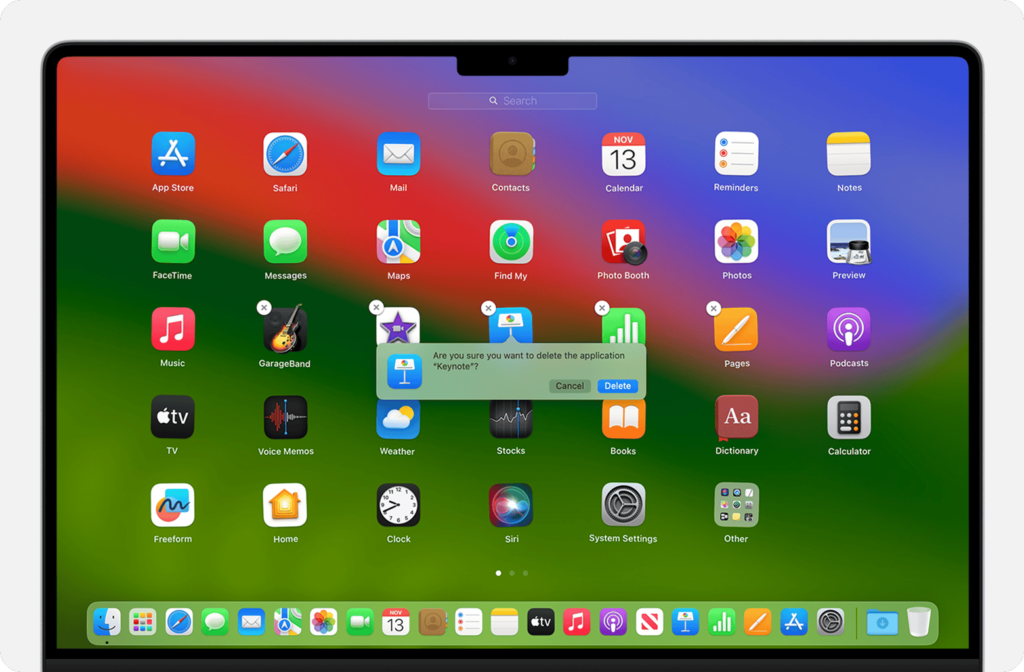Are you looking to declutter your Mac running macOS Sonoma by uninstalling unnecessary apps? If so, you’ve come to the right place.
Whether you’re new to the Mac ecosystem or seeking a refresher on the process, understanding how to effectively remove applications is essential.
In this blog, we’ll explore the various methods for removing applications from your Mac, ensuring a streamlined and efficient process.
How To Uninstall Apps On MacOS Sonoma?

To uninstall app on macOS Sonoma you can do this via Launchpad, or you can uninstall app using Finder, or via Terminal. After this you have to remove leftover files manually.
1. Uninstall Apps Via Launchpad

Uninstalling apps through Launchpad is a convenient method for apps installed from the Mac App Store.
It provides a simple, graphical way to manage and remove these apps, helping to keep your Mac clutter-free.
- To open Launchpad, click the Launchpad icon in the Dock, open it from your Applications folder, or use a pinch gesture with your thumb and three fingers on your trackpad.
- If you don’t see the app right away, use the search field at the top of Launchpad to find it.
- Navigate between pages of apps by clicking the dots at the bottom or swiping right or left with two fingers on your trackpad.
- Press and hold the Option (⌥) key, or click and hold any app until the apps begin to jiggle.
- Click the Delete button (x) that appears next to the app you wish to remove.
- Confirm the deletion by clicking Delete. The app is removed immediately.
2. Uninstall Apps Using Finder

Deleting apps using Finder is essential for removing non-App Store apps and can also be used for App Store apps.
This process helps in maintaining a clean system by getting rid of unwanted applications and freeing up disk space.
- Open Finder by clicking on the desktop or the Finder icon in the Dock.
- Navigate to your Applications folder. You can do this by clicking “Applications” in the sidebar of any Finder window or by selecting “Go” > “Applications” from the Finder’s menu bar.
- Find the app you want to delete within the Applications folder.
- You can delete the app by using one of the following methods:
- Drag the app to the Bin (Trash) in the Dock.
- While the app is selected, go to the menu bar and choose “File” > “Move to Bin.“

- Select the app and press Command (⌘) + Delete on your keyboard.
- If prompted, enter the username and password for an administrator account on your Mac. This is typically the credentials you use to log into your Mac.
- To permanently remove the app from your system, right-click on the Bin in the Dock and select “Empty Bin” or go to the Finder menu and choose “Finder” > “Empty Bin.“
3. Uninstall Apps Using Terminal
Using Terminal to uninstall programs on macOS Sonoma can be an effective solution for removing apps, especially those not listed in the Applications folder or those without a dedicated uninstall process.
This method is more direct and can also help remove associated files that are not deleted through the traditional drag-and-drop to the Bin method.

- Open Terminal by going to your Applications folder, then to the Utilities folder, and double-clicking on Terminal. You can also open it using Spotlight by pressing Command (⌘) + Space and typing “Terminal.“
- In the Terminal window, you’ll need to navigate to the Applications directory using the command
cd /Applications/. - Once you’re in the correct directory, you can list all the applications using the
lscommand to find the app you want to uninstall. - To remove the application, use the command
sudo rm -rf AppName.app/(replaceAppName.appwith the actual name of the app you want to uninstall). For example, if the app is called “SampleApp,” the command would besudo rm -rf SampleApp.app/. - Press Enter, and if prompted, enter your administrator password to execute the command.
4. Remove Leftover Files Manually
After uninstalling an app, there might be leftover files that need to be removed to ensure complete removal.
These residual files can take up unnecessary space and potentially cause conflicts with other software.
- Open Finder and select “Go” from the menu bar, then “Go to Folder.“
- Type in
~/Libraryand click “Go” to access the hidden Library folder. - Search for any files or folders related to the app you uninstalled. These can be located in subfolders such as
Application Support,Preferences, orCaches. - Drag these files to the Trash.
- Empty the Trash to permanently remove these files from your Mac.
5. Using Third-Party Uninstallers
Third-party uninstallers can automate the process of removing apps and their associated files.
These tools are useful for ensuring that no leftover files remain, which is particularly helpful for complex apps with numerous associated files.
- Download and install a reputable third-party uninstaller for macOS.
- Open the uninstaller application.
- Select the app you want to remove from the list provided by the uninstaller.
- Follow the on-screen instructions to uninstall the app, which typically includes the removal of associated files as well.
